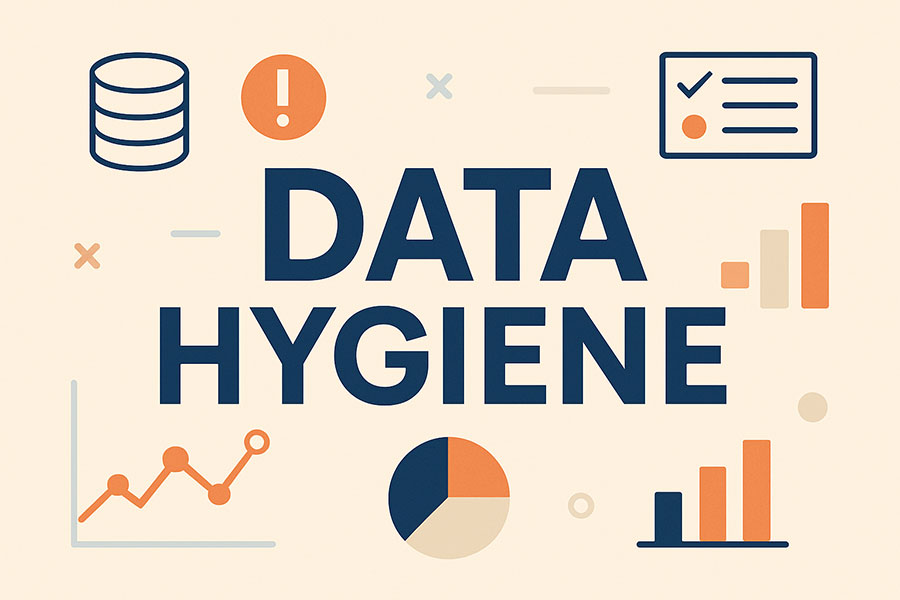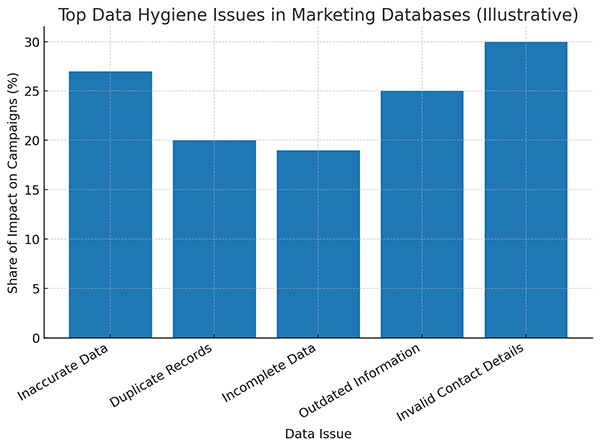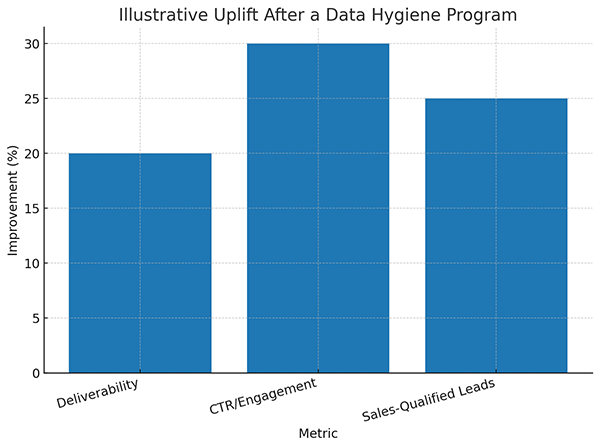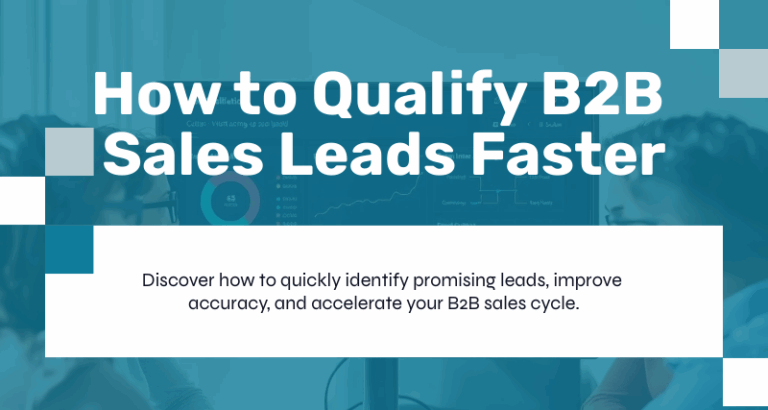
Marketing success depends on reaching the right people with the right message at the right time. But there’s a hidden factor that underpins every successful campaign: data hygiene. Poor data quality not only wastes marketing budgets but also undermines personalization, compliance, and customer trust. As businesses increasingly rely on advanced marketing automation and AI-driven targeting, maintaining accurate, clean, and actionable databases has never been more vital.
The Rising Importance of Data in Marketing
Modern marketing is data-driven. From segmenting audiences to personalizing emails, marketers rely on clean datasets to guide every decision. According to Gartner, poor data quality costs organizations an average of $12.9 million annually. Meanwhile, Experian reports that 29% of customer and prospect data is believed to be inaccurate across organizations.
For marketers, these inaccuracies mean:
- Wasted spend on undeliverable emails and wrong contacts
- Missed opportunities to reach qualified buyers
- Lower engagement and damaged sender reputation
- Skewed campaign analytics leading to poor decision-making
As competition increases, small errors compound into major losses. Inaccurate data isn’t just an inconvenience—it’s a revenue killer.
The Cost of Bad Data in Marketing Campaigns
The ripple effects of bad data are staggering. Consider email marketing: It is estimated that the average return on investment (ROI) for email marketing is $42 for every $1 spent. But that ROI only holds if campaigns actually reach the intended recipients.
Research shows that:
- 17% of email addresses in an average database are invalid within a year
- 30% of people change email addresses annually (due to job changes, new providers, etc.)
- 60% of companies lose a customer due to inaccurate contact information
Bad data reduces deliverability rates, increases bounce rates, and erodes sender reputation, which can lead to blacklisting by major ISPs. Ultimately, this inflates marketing costs while reducing campaign effectiveness.
The Most Common Data Hygiene Issues
Based on recent surveys, the top issues marketers face with their databases are:
- Inaccurate data (27%) – Wrong names, titles, industries, or demographic details.
- Duplicate records (20%) – Multiple entries for the same person, leading to wasted outreach and frustration.
- Incomplete data (19%) – Missing phone numbers, job titles, or email addresses prevent full profiling.
- Outdated information (25%) – Contacts who have moved companies, changed roles, or retired.
- Invalid contact details (30%) – Phone numbers and email addresses that no longer exist.
Here’s a snapshot of how these issues impact marketing performance:

Why Data Hygiene Matters More Today Than Ever
1. Explosion of Marketing Channels
Marketers are now engaging audiences across various channels, including email, social media, SMS, webinars, and more. Each channel requires accurate data to work effectively. Providing an incorrect mobile number or an outdated LinkedIn job title can derail an entire campaign sequence.
2. Hyper-Personalization Expectations
Today’s buyers expect personalized, relevant messages. Salesforce reports that 73% of customers expect companies to understand their needs and expectations. Without clean data, personalization can backfire—such as addressing someone by the wrong name or targeting a retired professional with a new career opportunity.
3. AI and Automation Depend on Clean Inputs
AI-driven tools can only be as effective as the data they’re fed. Garbage in, garbage out. Poor data hygiene leads to flawed segmentation, misguided predictive analytics, and ineffective nurturing workflows.
4. Regulatory Pressures (GDPR, CCPA, etc.)
Data privacy laws are stricter than ever. Inaccurate or outdated data increases the risk of non-compliance, hefty fines, and reputational damage. Clean, well-maintained databases reduce legal exposure.
5. Rising Customer Acquisition Costs
With customer acquisition costs (CAC) climbing steadily, wasting marketing dollars on bad data is no longer sustainable. A well-maintained database ensures resources are directed only toward valid, reachable prospects.
How Clean Data Boosts Marketing Results
Investing in data hygiene pays off in measurable ways:
- Better Deliverability: Valid, up-to-date contact records reduce bounce rates and protect sender reputation.
- Higher Engagement: Accurate personalization fosters stronger customer connections.
- Improved ROI: More accurate targeting means campaigns reach decision-makers who matter.
- Stronger Analytics: Clean data yields trustworthy reporting, enabling smarter marketing investments.
- Increased Trust: Customers appreciate accurate communication and are more likely to engage with trusted brands.
According to SiriusDecisions, organizations that maintain high-quality data see 66% higher conversion rates compared to those with poor data hygiene.

Best Practices for Maintaining Data Hygiene
- Regular Data Audits
Conduct quarterly or bi-annual reviews to identify inaccuracies, duplicates, and gaps. - Verification Tools
Utilize email verification, phone validation, and address cleansing tools to identify and correct errors before campaigns are launched. - Standardization
Ensure consistent data formatting (e.g., “U.S.” vs. “United States”) to prevent mismatches in segmentation. - Deduplication
Utilize software to merge duplicate records and maintain a single, accurate source of truth. - Progressive Profiling
Gather missing details gradually over multiple interactions, rather than relying on lengthy, off-putting forms. - Integration Across Systems
Sync CRM, marketing automation, and sales databases to prevent silos and inconsistencies. - Staff Training
Train team members on correct data entry procedures to reduce errors at the source.
Discover our comprehensive data hygiene solutions to learn how you can maintain accurate and campaign-ready records.
Case Example: The ROI of Data Hygiene
A B2B software company discovered that 25% of its CRM contacts were outdated. After implementing a structured data hygiene program—including verification and deduplication—the company saw:
- 20% increase in email deliverability
- 30% higher campaign engagement
- 25% more sales-qualified leads
- An overall $1.2 million boost in annual revenue is directly linked to improved data quality.
This example highlights the tangible ROI of investing in clean data.
Clean Data, Stronger Marketing
In marketing today, data is fuel—but only if it’s clean. As channels multiply, personalization becomes mandatory, and regulations tighten, the cost of poor data hygiene grows exponentially. By prioritizing accurate, up-to-date, and comprehensive data, marketers can enhance engagement, boost ROI, and mitigate compliance risks.
The message is clear: data hygiene is not optional—it’s a competitive advantage.
Marketers who embrace proactive data management will not only protect their campaigns from wasted spend but also position themselves to thrive in an increasingly data-driven future.
If you’re ready to strengthen your campaigns with accurate, actionable data, visit our Data Hygiene Services page.



